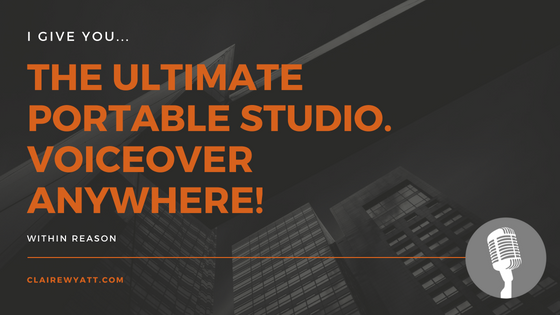Tried and tested portable voiceover kit – and the clients are happy!
You know how the story goes. You finally leave the house for a much needed holiday (having packed everything but the kitchen sink) for a few days away with a toddler. You’re 4 hours into a 5 hour journey the phone rings. It’s a client. A favourite client. With a crisis!
“Arrrrghhh, Claire, help! We need an extra line on the job you did the other day and our client wants it, like, YESTERDAY.”
Eeek. I can’t turn around and I really don’t want to let them down. But I’m heading to rural Wales with none of my voiceover kit.
What do I do?
Step in Amazon Prime.
I reassure the client that they’ll have their new line within 24 hours and I set to work. A spot of research and an order is placed. Within 12 hours my new, portable travel mic has arrived. I build an hilarious pillow fort to try and insulate the sound and create some nice acoustic treatment. And bosh. The line is recorded, sent and the client is over the moon.
Phew.
So, I now have a travel mic and a complete, portable vocal studio to take away when I travel. And it’s a good job too. On that little holiday I was able to save this clients skin, record a number of auditions at a much better quality than simply on my smart phone and I voiced some other work too. All of which work paid for the holiday! Huzzah.
Why would you need a travel kit?
Well, we all move around don’t we. Holidays, visiting family, working away etc.
I know, I know. I can hear voiceovers, agents and engineers all over the world screaming at me right now! “Travel kits are all wrong.” “You’ll never get a professional quality sound with your head under a duvet.” “USB mics are terrible.” “Take a holiday and forget about work.” etc. etc.
I agree to a certain extent. But…here’s the thing. Sometimes you need to record when you’re not at home. It’s really useful to be able to take some kit with you so you can pick-up lines, do appropriate jobs (more on that later) or record high quality auditions.
I know plenty of professional voiceovers who use portable set-ups and have recorded some high-profile gigs with their heads shoved in cupboards in hotel rooms. It can be done to a high standard if you know what you’re doing. And I do.
What’s in my portable voiceover set-up?
- I opted for an Audio Technica AT2020 USB+ mic. It’s USB so easily connects to any lap top. It comes with it’s own little stand which is fab. And it has an extra long cable which is great if your laptop is a little loud.
- For headphones I’d recommend Beyerdymanic DT 770 Pro cans. They are great for recording and editing and super comfy.
- Don’t forget a mouse if you want one
- And if you need an affordable laptop just for travel recording, I think this is a great deal: Gemini TC 10
Limitations and caveats
Having said all that, there are limitations. Obviously the AT2020 USB+ and a whole heap of soft furnising is not as good as the environment and equipment I have in my broadcast quality home studio. But if you know how to use the mic, how to create a better sound building a decent temporary pillow fort, how to edit and apply a little post-production then you really can record some decent quality stuff.
I think you have to be sensible about the kind of work you’ll do though. An audiobook? Not a chance. You’d never want to sit under a duvet for that long and the sound quality isn’t good enough. But if the end product is going to be over a music bed or sound FX and it’s going to an audio engineer or client who knows that you’re using your travel kit and accepts the terms; then go for it. Why not. I’ve certainly had no complaints so far.
So, all in all, I’m thrilled. I have a great little portable set up that fits in a small bag. It’s packed and ready so I can fly out the door with it at any moment. It’s easy to use and great quality. And, most importantly, the client is happy.

